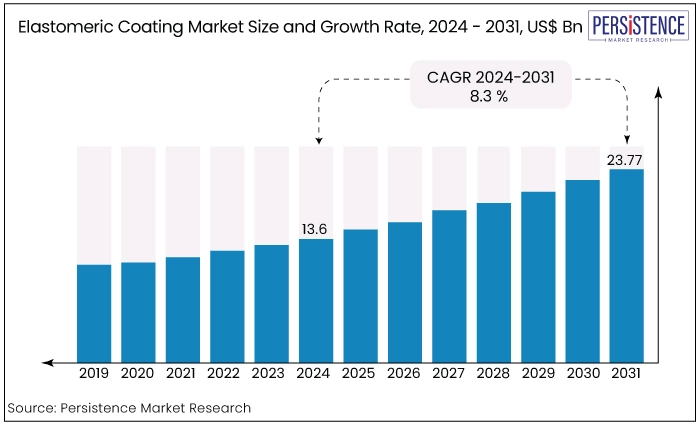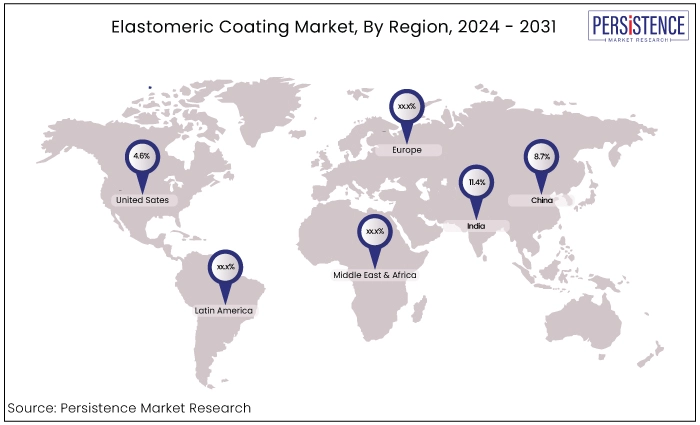Industry: Chemicals and Materials
Published Date: August-2024
Format: PPT*, PDF, EXCEL
Delivery Timelines: Contact Sales
Number of Pages: 195
Report ID: PMRREP34640
The global elastomeric coating market is estimated to value at US$23.77 Bn by the end of 2031 from US$13.6 Bn recorded in 2024. The market is expected to secure a CAGR of 8.3% during the forecast period from 2024 to 2031.
Key Highlights of the Market
|
Market Attributes |
Key Insights |
|
Elastomeric Coating Market Size (2024E) |
US$13.6 Bn |
|
Projected Market Value (2031F) |
US$23.77 Bn |
|
Forecast Growth Rate (CAGR 2024 to 2031) |
8.3 % |
|
Historical Growth Rate (CAGR 2019 to 2024) |
7.2 % |

|
Country |
CAGR through 2031 |
|
China |
8.7% |
China's elastomeric coating industry is expanding at a significant pace. By 2031, the country is projected to expand at a CAGR of 8.7%. Rapid urbanization and industrialization are the main drivers of growth. These have increased the need for novel coating materials in a number of industries, such as electronics, construction, and the automobile industry.
China keeps funding initiatives to expand its infrastructure and progress technology. As a result, there is an increased demand for high-performance elastomers for insulation, gaskets, and seals. Eco-friendly coatings have become more popular because of increased focus on environmental preservation and sustainability, which has sped up innovation and sales.

|
Country |
CAGR through 2031 |
|
The United States |
4.6% |
The United States market is projected to exhibit a CAGR of 4.6% during the forecast period from 2024 to 2031. Resistant to weather and extremely durable, liquid-applied roofing materials require less upkeep.
Strict norms and regulations have been put in place to encourage the use of ecological and energy-efficient materials. It is further expected that this will increase demand for these membranes. The country’s manufacturers are putting money into research with a view to creating cutting-edge coating solutions. These are specifically designed to fulfil the demands of the building industry.
The focused strategy solves key issues and improves performance in crucial areas, which not only supports growth but also expands. These include of elements including resilience to weather, sustainability, and durability.
|
Country |
CAGR through 2031 |
|
India |
11.4% |
The government of India has big ambitions for infrastructure development, which has an impact on expansion. Significant investments in rural and urban infrastructure have been sparked by these programs.
It is projected that favorable policies will increase the use of liquid-applied roofing membranes for a range of construction projects. By 2031, the nation is expected to have a CAGR of 11.4%.
The requirement for strong and weather-resistant building materials has increased due to an increase in extreme weather events in India. Developers of real estate, architects, and builders favor the coatings.
The market for these coatings has increased due to the growing emphasis on energy-efficient and sustainable construction methods, which is driving their expansion in India.
|
Category |
Projected CAGR through 2031 |
|
Type - Silicone Coating |
5.3% |
In the global sector, silicone is the top segment based on type. This segment is expected to account for 32.3% of the market share in 2024 because of its exceptional features that are suited for a wide range of applications.
Silicone coatings are renowned for their outstanding resilience to weather, robustness, and versatility, making them ideal for a variety of settings. These have excellent adherence properties that make them appropriate for a variety of substrates, such as metal, concrete, and roofing materials.
Long-term defense against water ingress and UV deterioration is provided by silicone compositions. These are essential for preserving structural integrity in the severe weather that is common in many areas.
The prevalence of silicone coatings is increased by the growing need for environmentally friendly solutions. Low volatile organic compound (VOC) content and energy-efficient properties make these coatings popular due to the increased emphasis on environmental responsibility.
|
Category |
Projected CAGR through 2031 |
|
Application – Building & Construction |
9.6% |
The building and construction industry is projected to account for 53.6% of the market in 2024 in terms of application. Basic demand for attractive and protective solutions supports the industry.
Innovative coatings are essential for protecting buildings from weathering and other environmental hazards. Over time, maintenance costs can be considerably decreased by improving the longevity and durability of building components.
The varied substrate needs of the construction industry, which include metal, concrete, and roofing materials, fuel demand for elastomeric coatings. These offer long-lasting protection and can stick to a variety of surfaces with effectiveness.
The demand for construction services is further driven by an increasing focus on energy efficiency and sustainable building methods. Because they promote good indoor air quality and environmental responsibility, coatings with low volatile organic compound concentration are becoming more and more popular.
Reflective coatings are expected to contribute to increased energy efficiency by minimizing heat absorption and, consequently, building cooling expenses. Complying with green building guidelines and standards strengthens the building and construction sector's standing.
The elastomeric coating market is witnessing significant growth due to its superior properties, such as high durability, flexibility, and excellent weather resistance. These coatings are extensively used in construction, automotive, and industrial applications to provide a protective layer that can withstand extreme temperatures and harsh environmental conditions.
The market study on elastomeric coating highlights innovations driving sector growth, emphasizing advancements in technology such as advanced formulations, improved application techniques, enhanced performance characteristics and market expansion in construction and infrastructure.
The rising demand for sustainable and energy-efficient solutions is driving the adoption of elastomeric coatings in both residential and commercial buildings. Technological advancements and innovation in product formulations are enhancing their performance and expanding their application scope.
With increasing investments in infrastructure development and a growing focus on extending the lifespan of buildings and structures, the elastomeric coating market is poised for substantial growth in the coming years.
The elastomeric coating market is driven by key trends and innovations, including the shift towards eco-friendly, low-VOC formulations in response to stringent environmental regulations and consumer demand for sustainability.
Innovations in nanotechnology are enhancing UV resistance, self-cleaning properties, and durability of these coatings. The development of energy-efficient coatings that reflect heat and reduce cooling costs is another significant trend.
The elastomeric coating market has experienced steady growth over the past decade, driven by advancements in material science and increased adoption in various industries. Historically, the market expanded due to the rising awareness of the benefits of elastomeric coatings, such as superior durability and flexibility compared to traditional coatings.
The construction sector especially has been a major contributor to market growth, with increased demand for protective coatings in both new builds and renovation projects. The market is expected to continue its upward trajectory, fueled by ongoing urbanization, infrastructure development, and the growing emphasis on sustainable building practices.
Innovations in eco-friendly and energy-efficient coating solutions will further propel market expansion, with emerging markets in Asia Pacific, and Latin America presenting significant growth opportunities.
Growing Construction Industry
The longevity of structures and their protection from environmental factors are greatly enhanced by these elastomeric coatings. Elastomeric coatings are frequently utilized for waterproofing, wall coatings, and roof coatings, among other building applications.
Elastomeric coating demand is being driven by infrastructure development projects and rising urbanization in emerging economies. Elastomeric coatings are becoming more and more in demand in the building sector due to increased knowledge of their advantages, which include lower maintenance costs and increased energy efficiency.
Growing Need for Coatings that Use Less Energy
The energy-efficient characteristics of elastomeric coatings are making them more and more attractive as a means of lowering buildings' overall energy usage. These coatings can reflect heat and UV light, which lessens the need for air conditioning and lowers energy expenses.
Elastomeric coating demand is predicted to increase as sustainability and energy efficiency gain more attention, especially in the building sector. Further encouraging their use in the building industry, elastomeric coatings can assist buildings in meeting energy efficiency regulations and certifications like LEED (Leadership in Energy and Environmental Design).
Strict Environmental Guidelines
Manufacturers must adhere to stringent regulations, which may raise production expenses and restrict the use of specific ingredients. Compliance involves reformulating coatings to lower VOC emissions, affecting elastomeric coating performance and cost efficiency.
Stringent regulations on VOC emissions and hazardous substances pose substantial market challenges. Moreover, monitoring and ensuring compliance with these regulations are intricate and time-consuming, compounding manufacturers' difficulties in the elastomeric coatings sector.
Limited Sturdiness in Dangerous Conditions
Despite their durability and weather resistance, elastomeric coatings may not perform optimally in extremely harsh environments, limiting their application in specific industries and regions.
Environments with high pollution levels, extreme temperatures, or exposure to harsh chemicals can accelerate the degradation of elastomeric coatings or reduce their protective efficacy. This constraint restricts their use in industries like heavy manufacturing, oil and gas, and marine, where coatings face severe conditions. Manufacturers and researchers are actively developing elastomeric coatings capable of withstanding such challenges, yet overcoming this remains a significant hurdle for the market.
Increasing Infrastructure Development
Elastomeric coatings are essential for preventing weathering and corrosion on infrastructure, including buildings, bridges, and roads. This prolongs the structures' lifespan and lowers maintenance costs.
The need for sustainable infrastructure and high-performance coatings that can endure challenging climatic conditions is developing along with urbanization.
Governments and contractors alike like elastomeric coatings because of their weather-resistant qualities and longevity, which make them perfect for infrastructure projects. Government programs and financial commitments to infrastructure development are opening up a sizable market for the industry.
Creation of Elastomeric Coatings Based on Biotechnology
Bio-based elastomeric coatings offer a competitive substitute for traditional petroleum-based coatings in light of the growing need for environmentally friendly coatings. These coatings are environmentally benign since they have fewer volatile organic compounds (VOCs) and less dependence on fossil fuels.
Furthermore, bio-based elastomeric coatings can function just as well as conventional coatings, providing a sustainable alternative without sacrificing performance.
Bio-based elastomeric coatings are predicted to have rapid growth and market opportunity as sustainability becomes more and more important to consumers and industry.
The competitive landscape of the elastomeric coating market features a diverse array of companies specializing in high-performance coatings. Key players such as Sherwin-Williams Company, PPG Industries, BASF SE, and Akzo Nobel N.V. dominate with extensive product portfolios and global market presence.
Market players emphasize continuous innovation in formulations to enhance durability, weather resistance, and application flexibility. Regional players also contribute significantly, focusing on niche markets and customization.
Strategic initiatives such as mergers, acquisitions, and collaborations are common, aiming to expand market reach and technological capabilities in response to increasing demand from construction, automotive, and industrial sectors.
Recent Industry Developments in the Elastomeric Coating Market
|
Attributes |
Details |
|
Forecast Period |
2024 to 2031 |
|
Historical Data Available for |
2018 to 2023 |
|
Market Analysis |
US$ Billion for Value |
|
Key Regions Covered |
|
|
Key Market Segments Covered |
|
|
Key Companies Profiled in the Report |
|
|
Report Coverage |
|
|
Customization & Pricing |
Available upon request |
By Type
By Technology
By Application
By Region
To know more about delivery timeline for this report Contact Sales

The market is estimated to be valued at US$13.6 Bn in 2024.
The demand for elastomeric coatings is surging due to increasing applications in construction, automotive, and industrial sectors for sustainable and protective solutions.
Some of the key players operating in the market are BASF SE, Sherwin-Williams Company, DowDuPont Inc., and Huntsman Corporation.
India is likely to account for the significant share in the market.
Building and construction sector segment recorded the significant market share.